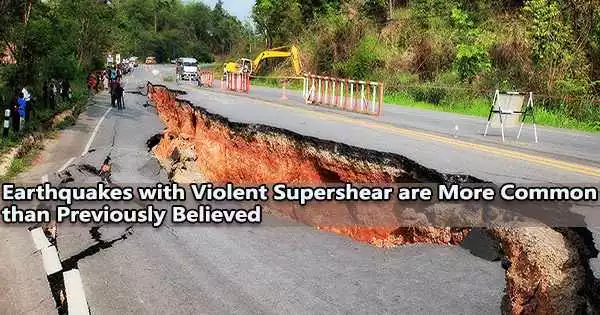According to a study headed by UCLA geophysicists and published today in Nature Geoscience, powerful supershear earthquakes, once thought to be rare, are significantly more prevalent than previously believed.
The scientists analyzed all 6.7-or-greater magnitude strike-slip earthquakes worldwide since 2000 there were 87 in all and identified 12 of the supershear type or about 14%. (Four of those earthquakes were previously unreported.)
Less than 6% of strike-slip earthquakes had previously been classified as supershear, which means that this percentage is more than twice what experts had anticipated.
When the margins of two tectonic plates collide sideways, strike-slip earthquakes result. Supershear earthquakes are a subtype of that category that happen when faults under the surface rupture more quickly than the rock-moving seismic waves that cause the ground to tremble can shear. The effect is similar to a sonic boom in that it gathers energy that is subsequently forcefully discharged.
As a result, compared to other earthquakes of the same size, supershear earthquakes tend to cause greater shaking and may be more damaging.
“When an airplane flies faster than sound can travel through the air, a cone of pent-up sound waves forms in front of the plane and when it catches up, we hear it all at once,” said Lingsen Meng, UCLA’s Leon and Joanne V.C. Knopoff Professor of Physics and Geophysics, and the paper’s corresponding author. “Supershear earthquakes are potentially more destructive than other kinds of earthquakes because they are more effective at generating seismic waves, with more shaking, which could cause more damage.”
The study also discovered that strike-slip faults, like California’s San Andreas Fault, are where supershear earthquakes are most likely to strike, and that these earthquakes happen just as frequently beneath the oceans as they do on land.
Considering if adjacent faults are capable of creating supershear earthquakes and, if so, taking precautions to prepare for a higher level of shaking and probable damage than could be generated by non-supershear earthquakes, are suggested as important considerations in disaster planning efforts.
When an airplane flies faster than sound can travel through the air, a cone of pent-up sound waves forms in front of the plane and when it catches up, we hear it all at once. Supershear earthquakes are potentially more destructive than other kinds of earthquakes because they are more effective at generating seismic waves, with more shaking, which could cause more damage.
Lingsen Meng
Meng said the reason relatively few supershear earthquakes have been found is that researchers mainly study earthquakes on land.
The paper’s co-authors are UCLA doctoral students Han Bao and Liuwei Xu of UCLA and Jean-Paul Ampuero, a senior researcher at Université Côte d’Azur in Nice, France.
To estimate how quickly an earthquake moves down the fault, the researchers employed a technique called backprojection to establish the direction in which seismic waves arrived. The method uses an algorithm to examine small intervals of time between seismic waves as they are picked up by a number of sensors. The process is comparable to finding someone by following the signals that person’s smartphone transmits to cell towers.
The data showed that mature strike-slip faults, where the borders of two continental plates scrape against each other laterally, are where supershear earthquakes typically occur. This process has been going on for long enough in a mature fault to produce a zone of damaged rocks that act as a dam around the fault, slowing or preventing seismic wave propagation and concentrating their energy.
Ampuero said the findings could help scientists better understand what it takes for a fault to produce the kinds of ruptures that lead to supershear earthquakes.
In the past century, at least one large supershear earthquake has occurred in California: In 1979, a 6.5-magnitude quake in Southern California’s Imperial Valley region injured people as far away as Mexico and caused extensive damage to irrigation systems. The 1906 earthquake that severely damaged San Francisco, albeit it occurred before scientific monitoring, was also probably a supershear event.
Not all supershear earthquakes are that disastrous. The fault’s structure, the rocks nearby, and other elements can influence the propagation of seismic waves and the amount of energy that can accumulate. Seismic waves are more likely to be slowed, refracted, or absorbed by curved faults than by straight ones.
In a previous study, Meng’s research group identified the catastrophic 7.5 magnitude earthquake that hit the Indonesian island of Sulawesi in 2018 as a supershear event. The temblor and ensuing tsunami killed at least 4,000 people.
“Despite the curve in the Indonesian earthquake fault, the horrific damage occurred because the fault moved faster than any previously recorded, and energy from earlier temblors likely were stored up in the rocks, awaiting a moment to burst,” Meng said.
Fortunately, Meng said supershear earthquakes in the ocean are less likely than earthquakes that cause the sea floor to move vertically to produce tsunamis.
Contrarily, the San Andreas Fault is largely straight and has the potential for a rupture that is considerably more catastrophic than the Sulawesi earthquake.





